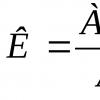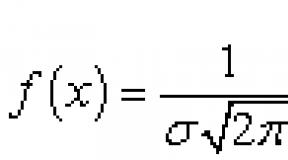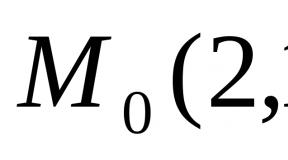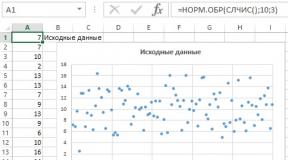Features of the structure of the membrane. outer cell membrane. How does the cell feed through the cell membrane?
Outer cell membrane (plasmalemma, cytolemma, plasma membrane) of animal cells covered on the outside (i.e., on the side not in contact with the cytoplasm) with a layer of oligosaccharide chains covalently attached to membrane proteins (glycoproteins) and, to a lesser extent, to lipids (glycolipids). This carbohydrate coating of the membrane is called glycocalyx. The purpose of the glycocalyx is not yet very clear; there is an assumption that this structure takes part in the processes of intercellular recognition.
In plant cells on top of the outer cell membrane is a dense cellulose layer with pores through which communication is carried out between neighboring cells through cytoplasmic bridges.
Cells mushrooms on top of the plasmalemma - a dense layer chitin.
At bacteria – mureina.
Properties of biological membranes
1. Ability to self-assemble after destructive impacts. This property is determined by the physicochemical characteristics of phospholipid molecules, which in an aqueous solution come together so that the hydrophilic ends of the molecules turn outward, and the hydrophobic ends inward. Proteins can be incorporated into ready-made phospholipid layers. The ability to self-assemble is essential at the cellular level.
2. Semi-permeability(selectivity in the transmission of ions and molecules). Ensures the maintenance of the constancy of the ionic and molecular composition in the cell.
3. Membrane fluidity. Membranes are not rigid structures; they constantly fluctuate due to the rotational and oscillatory movements of lipid and protein molecules. This provides a high rate of enzymatic and other chemical processes in the membranes.
4. Fragments of membranes do not have free ends, as they are closed in bubbles.
Functions of the outer cell membrane (plasmalemma)
The main functions of the plasmalemma are as follows: 1) barrier, 2) receptor, 3) exchange, 4) transport.
1. barrier function. It is expressed in the fact that the plasmalemma limits the contents of the cell, separating it from the external environment, and intracellular membranes divide the cytoplasm into separate reactionary compartments.
2. receptor function. One of the most important functions of the plasmalemma is to ensure communication (connection) of the cell with the external environment through the receptor apparatus present in the membranes, which has a protein or glycoprotein nature. The main function of the receptor formations of the plasmalemma is the recognition of external signals, due to which the cells are correctly oriented and form tissues in the process of differentiation. The activity of various regulatory systems, as well as the formation of an immune response, is associated with the receptor function.
exchange function is determined by the content of enzyme proteins in biological membranes, which are biological catalysts. Their activity varies depending on the pH of the medium, temperature, pressure, the concentration of both the substrate and the enzyme itself. Enzymes determine the intensity of key reactions metabolism, as well as orientation.
Transport function of membranes. The membrane provides selective penetration into the cell and from the cell into the environment of various chemicals. The transport of substances is necessary to maintain the appropriate pH in the cell, the proper ionic concentration, which ensures the efficiency of cellular enzymes. Transport supplies nutrients that serve as a source of energy, as well as material for the formation of various cellular components. It determines the removal of toxic waste from the cell, the secretion of various useful substances and the creation of ionic gradients necessary for nervous and muscle activity. Changes in the rate of transfer of substances can lead to disturbances in bioenergetic processes, water-salt metabolism, excitability and other processes. Correction of these changes underlies the action of many drugs.
There are two main ways in which substances enter the cell and out of the cell into the external environment;
passive transport,
active transport.
Passive transport goes along the gradient of chemical or electrochemical concentration without the expenditure of ATP energy. If the molecule of the transported substance has no charge, then the direction of passive transport is determined only by the difference in the concentration of this substance on both sides of the membrane (chemical concentration gradient). If the molecule is charged, then its transport is affected by both the chemical concentration gradient and the electrical gradient (membrane potential).
Both gradients together constitute an electrochemical gradient. Passive transport of substances can be carried out in two ways: simple diffusion and facilitated diffusion.
With simple diffusion salt ions and water can penetrate through the selective channels. These channels are formed by some transmembrane proteins that form end-to-end transport pathways that are open permanently or only for a short time. Through the selective channels, various molecules penetrate, having the size and charge corresponding to the channels.
There is another way of simple diffusion - this is the diffusion of substances through the lipid bilayer, through which fat-soluble substances and water easily pass. The lipid bilayer is impermeable to charged molecules (ions), and at the same time, uncharged small molecules can freely diffuse, and the smaller the molecule, the faster it is transported. The rather high rate of water diffusion through the lipid bilayer is precisely due to the small size of its molecules and the absence of a charge.
With facilitated diffusion proteins are involved in the transport of substances - carriers that work on the principle of "ping-pong". In this case, the protein exists in two conformational states: in the “pong” state, the binding sites of the transported substance are open on the outside of the bilayer, and in the “ping” state, the same sites open on the other side. This process is reversible. From which side the binding site of a substance will be open at a given time depends on the concentration gradient of this substance.
In this way, sugars and amino acids pass through the membrane.
With facilitated diffusion, the rate of transport of substances increases significantly in comparison with simple diffusion.
In addition to carrier proteins, some antibiotics, such as gramicidin and valinomycin, are involved in facilitated diffusion.
Because they provide ion transport, they are called ionophores.
Active transport of substances in the cell. This type of transport always comes with the cost of energy. The source of energy needed for active transport is ATP. A characteristic feature of this type of transport is that it is carried out in two ways:
with the help of enzymes called ATPases;
transport in membrane packaging (endocytosis).
AT the outer cell membrane contains enzyme proteins such as ATPases, whose function is to provide active transport ions against a concentration gradient. Since they provide the transport of ions, this process is called an ion pump.
There are four main ion transport systems in the animal cell. Three of them provide transfer through biological membranes. Na + and K +, Ca +, H +, and the fourth - the transfer of protons during the operation of the mitochondrial respiratory chain.
An example of an active ion transport mechanism is sodium-potassium pump in animal cells. It maintains a constant concentration of sodium and potassium ions in the cell, which differs from the concentration of these substances in the environment: normally, there are less sodium ions in the cell than in the environment, and more potassium.
As a result, according to the laws of simple diffusion, potassium tends to leave the cell, and sodium diffuses into the cell. In contrast to simple diffusion, the sodium-potassium pump constantly pumps out sodium from the cell and injects potassium: for three molecules of sodium thrown out, there are two molecules of potassium introduced into the cell.
This transport of sodium-potassium ions is ensured by the ATP-dependent enzyme, which is localized in the membrane in such a way that it penetrates its entire thickness. Sodium and ATP enter this enzyme from the inside of the membrane, and potassium from the outside.
The transfer of sodium and potassium across the membrane occurs as a result of conformational changes that the sodium-potassium-dependent ATPase undergoes, which is activated when the concentration of sodium inside the cell or potassium in the environment increases.
ATP hydrolysis is required to power this pump. This process is provided by the same enzyme sodium-potassium-dependent ATP-ase. At the same time, more than one third of the ATP consumed by the animal cell at rest is spent on the work of the sodium - potassium pump.
Violation of the proper functioning of the sodium - potassium pump leads to various serious diseases.
The efficiency of this pump exceeds 50%, which is not achieved by the most advanced machines created by man.
Many active transport systems are driven by energy stored in ionic gradients rather than by direct hydrolysis of ATP. All of them work as cotransport systems (facilitating the transport of low molecular weight compounds). For example, the active transport of certain sugars and amino acids into animal cells is determined by the sodium ion gradient, and the higher the sodium ion gradient, the greater the rate of glucose absorption. Conversely, if the concentration of sodium in the intercellular space decreases markedly, glucose transport stops. In this case, sodium must join the sodium - dependent glucose carrier protein, which has two binding sites: one for glucose, the other for sodium. Sodium ions penetrating into the cell contribute to the introduction of the carrier protein into the cell along with glucose. Sodium ions that have entered the cell along with glucose are pumped back out by the sodium-potassium-dependent ATPase, which, by maintaining the sodium concentration gradient, indirectly controls glucose transport.
Transport of substances in membrane packaging. Large molecules of biopolymers practically cannot penetrate through the plasmalemma by any of the above-described mechanisms of transport of substances into the cell. They are captured by the cell and absorbed in the membrane package, which is called endocytosis. The latter is formally divided into phagocytosis and pinocytosis. The capture of solid particles by the cell is phagocytosis, and liquid - pinocytosis. During endocytosis, the following stages are observed:
reception of the absorbed substance due to receptors in the cell membrane;
invagination of the membrane with the formation of a bubble (vesicles);
separation of the endocytic vesicle from the membrane with the expenditure of energy - phagosome formation and restoration of membrane integrity;
Fusion of phagosome with lysosome and formation phagolysosomes (digestive vacuole) in which the digestion of absorbed particles occurs;
removal of undigested material in the phagolysosome from the cell ( exocytosis).
In the animal world endocytosis is a characteristic way of feeding many unicellular organisms (for example, in amoebas), and among multicellular organisms this type of digestion of food particles is found in endodermal cells in coelenterates. As for mammals and humans, they have a reticulo-histio-endothelial system of cells with the ability to endocytosis. Examples are blood leukocytes and liver Kupffer cells. The latter line the so-called sinusoidal capillaries of the liver and capture various foreign particles suspended in the blood. Exocytosis- this is also a way of removing from the cell of a multicellular organism the substrate secreted by it, which is necessary for the function of other cells, tissues and organs.
The cell membrane is the planar structure from which the cell is built. It is present in all organisms. Its unique properties ensure the vital activity of cells.
Types of membranes
There are three types of cell membranes:
- outdoor;
- nuclear;
- organelle membranes.
The outer cytoplasmic membrane creates the boundaries of the cell. It should not be confused with the cell wall or membrane found in plants, fungi and bacteria.
The difference between the cell wall and the cell membrane is in a much greater thickness and the predominance of the protective function over the exchange. The membrane is located under the cell wall.
The nuclear membrane separates the contents of the nucleus from the cytoplasm.
TOP 4 articleswho read along with this
Among the cell organelles there are those whose shape is formed by one or two membranes:
- mitochondria;
- plastids;
- vacuoles;
- Golgi complex;
- lysosomes;
- endoplasmic reticulum (ER).
Membrane structure
According to modern concepts, the structure of the cell membrane is described using a fluid mosaic model. The basis of the membrane is the lipid layer - two levels of lipid molecules forming a plane. Protein molecules are located on both sides of the bilipid layer. Some proteins are immersed in the bilipid layer, some pass through it.

Rice. 1. Cell membrane.
Animal cells have a complex of carbohydrates on the membrane surface. When studying the cell under a microscope, it was noted that the membrane is in constant motion and is heterogeneous in structure.
The membrane is a mosaic both in the morphological and functional sense, since its different parts contain different substances and have different physiological properties.
Properties and functions
Any border structure performs protective and exchange functions. This applies to all types of membranes.
The implementation of these functions is facilitated by such properties as:
- plastic;
- high ability to recover;
- semipermeability.
The property of semi-permeability lies in the fact that some substances are not passed through the membrane, while others are passed freely. This is how the controlling function of the membrane is carried out.
Also, the outer membrane provides communication between cells due to numerous outgrowths and the release of an adhesive that fills the intercellular space.
Transport of substances across the membrane
Substances pass through the outer membrane in the following ways:
- through the pores with the help of enzymes;
- through the membrane directly;
- pinocytosis;
- phagocytosis.
The first two ways transport ions and small molecules. Large molecules enter the cell by pinocytosis (in liquid state) and phagocytosis (in solid form).

Rice. 2. Scheme of pino- and phagocytosis.
The membrane wraps around the food particle and closes it into the digestive vacuole.
Water and ions pass into the cell without energy expenditure, by passive transport. Large molecules move by active transport, with the expenditure of energy resources.
intracellular transport
From 30% to 50% of the cell volume is occupied by the endoplasmic reticulum. This is a kind of system of cavities and channels that connects all parts of the cell and provides an ordered intracellular transport of substances.

Rice. 3. EPS drawing.
Thus, a significant mass of cell membranes is concentrated in the EPS.
What have we learned?
We found out what a cell membrane is in biology. It is the structure upon which all living cells are built. Its significance in the cell lies in: delimiting the space of organelles, the nucleus and the cell as a whole, ensuring the selective entry of substances into the cell and nucleus. The membrane contains lipid and protein molecules.
Topic quiz
Report Evaluation
Average rating: 4.7. Total ratings received: 468.
In 1972, the theory was put forward that a partially permeable membrane surrounds the cell and performs a number of vital tasks, and the structure and function of cell membranes are significant issues regarding the proper functioning of all cells in the body. became widespread in the 17th century, along with the invention of the microscope. It became known that plant and animal tissues are composed of cells, but due to the low resolution of the device, it was impossible to see any barriers around the animal cell. In the 20th century, the chemical nature of the membrane was studied in more detail, it was found that lipids are its basis.
The structure and functions of cell membranes
The cell membrane surrounds the cytoplasm of living cells, physically separating intracellular components from the external environment. Fungi, bacteria and plants also have cell walls that provide protection and prevent the passage of large molecules. Cell membranes also play a role in the development of the cytoskeleton and the attachment of other vital particles to the extracellular matrix. This is necessary in order to hold them together, forming the tissues and organs of the body. Structural features of the cell membrane include permeability. The main function is protection. The membrane consists of a phospholipid layer with embedded proteins. This part is involved in processes such as cell adhesion, ionic conduction, and signaling systems and serves as an attachment surface for several extracellular structures, including the wall, glycocalyx, and internal cytoskeleton. The membrane also maintains the potential of the cell by acting as a selective filter. It is selectively permeable to ions and organic molecules and controls the movement of particles.

Biological mechanisms involving the cell membrane
1. Passive diffusion: some substances (small molecules, ions), such as carbon dioxide (CO2) and oxygen (O2), can diffuse through the plasma membrane. The shell acts as a barrier to certain molecules and ions that can be concentrated on either side.
2. Transmembrane protein channels and transporters: Nutrients such as glucose or amino acids must enter the cell, and some metabolic products must leave it.
3. Endocytosis is the process by which molecules are taken up. A slight deformation (invagination) is created in the plasma membrane, in which the substance to be transported is swallowed. It requires energy and is thus a form of active transport.
4. Exocytosis: occurs in various cells to remove undigested residues of substances brought by endocytosis, to secrete substances such as hormones and enzymes, and transport the substance completely through the cell barrier.

molecular structure
The cell membrane is a biological membrane, consisting mainly of phospholipids and separating the contents of the entire cell from the external environment. The formation process occurs spontaneously under normal conditions. To understand this process and correctly describe the structure and functions of cell membranes, as well as properties, it is necessary to assess the nature of phospholipid structures, which are characterized by structural polarization. When phospholipids in the aqueous environment of the cytoplasm reach a critical concentration, they combine into micelles, which are more stable in the aqueous environment.

Membrane properties
- Stability. This means that after the formation of the membrane is unlikely to disintegrate.
- Strength. The lipid membrane is sufficiently reliable to prevent the passage of a polar substance; both dissolved substances (ions, glucose, amino acids) and much larger molecules (proteins) cannot pass through the formed boundary.
- dynamic character. This is perhaps the most important property when considering the structure of the cell. The cell membrane can be subjected to various deformations, it can fold and bend without collapsing. Under special circumstances, such as the fusion of vesicles or budding, it can be broken, but only temporarily. At room temperature, its lipid components are in constant, chaotic motion, forming a stable fluid boundary.

Liquid mosaic model
Speaking about the structure and functions of cell membranes, it is important to note that in the modern view, the membrane as a liquid mosaic model was considered in 1972 by scientists Singer and Nicholson. Their theory reflects three main features of the membrane structure. The integrals provide a mosaic template for the membrane, and they are capable of lateral in-plane movement due to the variable nature of lipid organization. Transmembrane proteins are also potentially mobile. An important feature of the membrane structure is its asymmetry. What is the structure of a cell? Cell membrane, nucleus, proteins and so on. The cell is the basic unit of life, and all organisms are made up of one or more cells, each with a natural barrier separating it from its environment. This outer border of the cell is also called the plasma membrane. It is made up of four different types of molecules: phospholipids, cholesterol, proteins and carbohydrates. The liquid mosaic model describes the structure of the cell membrane as follows: flexible and elastic, with a consistency similar to vegetable oil, so that all individual molecules simply float in the liquid medium, and they are all able to move sideways within this shell. A mosaic is something that contains many different details. In the plasma membrane, it is represented by phospholipids, cholesterol molecules, proteins and carbohydrates.
Phospholipids
Phospholipids make up the basic structure of the cell membrane. These molecules have two distinct ends: a head and a tail. The head end contains a phosphate group and is hydrophilic. This means that it is attracted to water molecules. The tail is made up of hydrogen and carbon atoms called fatty acid chains. These chains are hydrophobic, they do not like to mix with water molecules. This process is similar to what happens when you pour vegetable oil into water, that is, it does not dissolve in it. The structural features of the cell membrane are associated with the so-called lipid bilayer, which consists of phospholipids. Hydrophilic phosphate heads are always located where there is water in the form of intracellular and extracellular fluid. The hydrophobic tails of phospholipids in the membrane are organized in such a way that they keep them away from water.

Cholesterol, proteins and carbohydrates
When people hear the word "cholesterol", people usually think it's bad. However, cholesterol is actually a very important component of cell membranes. Its molecules consist of four rings of hydrogen and carbon atoms. They are hydrophobic and occur among the hydrophobic tails in the lipid bilayer. Their importance lies in maintaining consistency, they strengthen the membranes, preventing crossover. Cholesterol molecules also keep the phospholipid tails from coming into contact and hardening. This guarantees fluidity and flexibility. Membrane proteins act as enzymes to speed up chemical reactions, act as receptors for specific molecules, or transport substances across the cell membrane.
Carbohydrates, or saccharides, are found only on the extracellular side of the cell membrane. Together they form the glycocalyx. It provides cushioning and protection to the plasma membrane. Based on the structure and type of carbohydrates in the glycocalyx, the body can recognize the cells and determine if they should be there or not.
Membrane proteins
The structure of the cell membrane cannot be imagined without such a significant component as protein. Despite this, they can be significantly inferior in size to another important component - lipids. There are three main types of membrane proteins.
- Integral. They completely cover the bi-layer, cytoplasm and extracellular environment. They perform a transport and signaling function.
- Peripheral. Proteins are attached to the membrane by electrostatic or hydrogen bonds at their cytoplasmic or extracellular surfaces. They are involved mainly as a means of attachment for integral proteins.
- Transmembrane. They perform enzymatic and signaling functions, and also modulate the basic structure of the lipid bilayer of the membrane.

Functions of biological membranes
The hydrophobic effect, which regulates the behavior of hydrocarbons in water, controls structures formed by membrane lipids and membrane proteins. Many properties of membranes are conferred by carriers of lipid bilayers, which form the basic structure for all biological membranes. Integral membrane proteins are partially hidden in the lipid bilayer. Transmembrane proteins have a specialized organization of amino acids in their primary sequence.
Peripheral membrane proteins are very similar to soluble proteins, but they are also membrane bound. Specialized cell membranes have specialized cell functions. How do the structure and functions of cell membranes affect the body? The functionality of the whole organism depends on how biological membranes are arranged. From intracellular organelles, extracellular and intercellular interactions of membranes, the structures necessary for the organization and performance of biological functions are created. Many structural and functional features are shared between bacteria and enveloped viruses. All biological membranes are built on a lipid bilayer, which determines the presence of a number of common characteristics. Membrane proteins have many specific functions.
- Controlling. Plasma membranes of cells determine the boundaries of the interaction of the cell with the environment.
- Transport. The intracellular membranes of cells are divided into several functional blocks with different internal composition, each of which is supported by the necessary transport function in combination with control permeability.
- signal transduction. Membrane fusion provides a mechanism for intracellular vesicular notification and preventing various kinds of viruses from freely entering the cell.

Significance and conclusions
The structure of the outer cell membrane affects the entire body. It plays an important role in protecting integrity by allowing only selected substances to penetrate. It is also a good base for anchoring the cytoskeleton and cell wall, which helps in maintaining the shape of the cell. Lipids make up about 50% of the membrane mass of most cells, although this varies depending on the type of membrane. The structure of the outer cell membrane of mammals is more complex, it contains four main phospholipids. An important property of lipid bilayers is that they behave like a two-dimensional fluid in which individual molecules can freely rotate and move laterally. Such fluidity is an important property of membranes, which is determined depending on temperature and lipid composition. Due to the hydrocarbon ring structure, cholesterol plays a role in determining the fluidity of membranes. biological membranes for small molecules allows the cell to control and maintain its internal structure.
Considering the structure of the cell (cell membrane, nucleus, and so on), we can conclude that the body is a self-regulating system that cannot harm itself without outside help and will always look for ways to restore, protect and properly function each cell.
cell membrane
Image of a cell membrane. Small blue and white balls correspond to the hydrophobic "heads" of the phospholipids, and the lines attached to them correspond to the hydrophilic "tails". The figure shows only integral membrane proteins (red globules and yellow helices). Yellow oval dots inside the membrane - cholesterol molecules Yellow-green chains of beads on the outside of the membrane - oligosaccharide chains that form the glycocalyx
The biological membrane also includes various proteins: integral (penetrating the membrane through), semi-integral (immersed at one end into the outer or inner lipid layer), surface (located on the outer or adjacent to the inner sides of the membrane). Some proteins are the points of contact of the cell membrane with the cytoskeleton inside the cell, and the cell wall (if any) outside. Some of the integral proteins function as ion channels, various transporters, and receptors.
Functions
- barrier - provides a regulated, selective, passive and active metabolism with the environment. For example, the peroxisome membrane protects the cytoplasm from peroxides dangerous to the cell. Selective permeability means that the permeability of a membrane to various atoms or molecules depends on their size, electrical charge, and chemical properties. Selective permeability ensures the separation of the cell and cellular compartments from the environment and supply them with the necessary substances.
- transport - through the membrane there is a transport of substances into the cell and out of the cell. Transport through the membranes provides: the delivery of nutrients, the removal of end products of metabolism, the secretion of various substances, the creation of ionic gradients, the maintenance of the optimal concentration of ions in the cell, which are necessary for the functioning of cellular enzymes.
Particles that for some reason are unable to cross the phospholipid bilayer (for example, due to hydrophilic properties, since the membrane is hydrophobic inside and does not allow hydrophilic substances to pass through, or because of their large size), but necessary for the cell, can penetrate the membrane through special carrier proteins (transporters) and channel proteins or by endocytosis.
In passive transport, substances cross the lipid bilayer without energy expenditure along the concentration gradient by diffusion. A variant of this mechanism is facilitated diffusion, in which a specific molecule helps a substance to pass through the membrane. This molecule may have a channel that allows only one type of substance to pass through.
Active transport requires energy, as it occurs against a concentration gradient. There are special pump proteins on the membrane, including ATPase, which actively pumps potassium ions (K +) into the cell and pumps sodium ions (Na +) out of it. - matrix - provides a certain relative position and orientation of membrane proteins, their optimal interaction.
- mechanical - ensures the autonomy of the cell, its intracellular structures, as well as connection with other cells (in tissues). Cell walls play an important role in providing mechanical function, and in animals - intercellular substance.
- energy - during photosynthesis in chloroplasts and cellular respiration in mitochondria, energy transfer systems operate in their membranes, in which proteins also participate;
- receptor - some proteins located in the membrane are receptors (molecules with which the cell perceives certain signals).
For example, hormones circulating in the blood only act on target cells that have receptors corresponding to these hormones. Neurotransmitters (chemicals that conduct nerve impulses) also bind to specific receptor proteins on target cells. - enzymatic - membrane proteins are often enzymes. For example, the plasma membranes of intestinal epithelial cells contain digestive enzymes.
- implementation of generation and conduction of biopotentials.
With the help of the membrane, a constant concentration of ions is maintained in the cell: the concentration of the K + ion inside the cell is much higher than outside, and the concentration of Na + is much lower, which is very important, since this maintains the potential difference across the membrane and generates a nerve impulse. - cell marking - there are antigens on the membrane that act as markers - "labels" that allow the cell to be identified. These are glycoproteins (that is, proteins with branched oligosaccharide side chains attached to them) that play the role of "antennas". Due to the myriad of side chain configurations, it is possible to make a specific marker for each cell type. With the help of markers, cells can recognize other cells and act in concert with them, for example, when forming organs and tissues. It also allows the immune system to recognize foreign antigens.
Structure and composition of biomembranes
Membranes are composed of three classes of lipids: phospholipids, glycolipids, and cholesterol. Phospholipids and glycolipids (lipids with carbohydrates attached to them) consist of two long hydrophobic hydrocarbon "tails" that are associated with a charged hydrophilic "head". Cholesterol stiffens the membrane by occupying the free space between the hydrophobic lipid tails and preventing them from bending. Therefore, membranes with a low cholesterol content are more flexible, while those with a high cholesterol content are more rigid and brittle. Cholesterol also serves as a “stopper” that prevents the movement of polar molecules from and into the cell. An important part of the membrane is made up of proteins penetrating it and responsible for various properties of membranes. Their composition and orientation in different membranes differ.
Cell membranes are often asymmetric, that is, the layers differ in lipid composition, the transition of an individual molecule from one layer to another (the so-called flip flop) is difficult.
Membrane organelles
These are closed single or interconnected sections of the cytoplasm, separated from the hyaloplasm by membranes. Single-membrane organelles include endoplasmic reticulum, Golgi apparatus, lysosomes, vacuoles, peroxisomes; to two-membrane - nucleus, mitochondria, plastids. The structure of the membranes of various organelles differs in the composition of lipids and membrane proteins.
Selective permeability
Cell membranes have selective permeability: glucose, amino acids, fatty acids, glycerol and ions slowly diffuse through them, and the membranes themselves actively regulate this process to a certain extent - some substances pass through, while others do not. There are four main mechanisms for the entry of substances into the cell or their removal from the cell to the outside: diffusion, osmosis, active transport and exo- or endocytosis. The first two processes are passive in nature, that is, they do not require energy; the last two are active processes associated with energy consumption.
The selective permeability of the membrane during passive transport is due to special channels - integral proteins. They penetrate the membrane through and through, forming a kind of passage. The elements K, Na and Cl have their own channels. With respect to the concentration gradient, the molecules of these elements move in and out of the cell. When irritated, the sodium ion channels open, and there is a sharp influx of sodium ions into the cell. This results in an imbalance in the membrane potential. After that, the membrane potential is restored. Potassium channels are always open, through which potassium ions slowly enter the cell.
see also
Literature
- Antonov V. F., Smirnova E. N., Shevchenko E. V. Lipid membranes during phase transitions. - M .: Nauka, 1994.
- Gennis R. Biomembranes. Molecular structure and functions: translation from English. = Biomembranes. Molecular structure and function (by Robert B. Gennis). - 1st edition. - M .: Mir, 1997. - ISBN 5-03-002419-0
- Ivanov V. G., Berestovsky T. N. lipid bilayer of biological membranes. - M .: Nauka, 1982.
- Rubin A. B. Biophysics, textbook in 2 vols. - 3rd edition, revised and expanded. - M .: Moscow University Press, 2004. - ISBN 5-211-06109-8
- Bruce Alberts, et al.
13. Biological cell membranes. Their properties, structure and functions.
plasma membrane , or plasmalemma,- the most permanent, basic, universal membrane for all cells. It is the thinnest (about 10 nm) film covering the entire cell. The plasmalemma consists of molecules of proteins and phospholipids (Fig. 1.6).
Molecules of phospholipids are arranged in two rows - hydrophobic ends inward, hydrophilic heads to the internal and external aquatic environment. In some places, the bilayer (double layer) of phospholipids is permeated through with protein molecules (integral proteins). Inside such protein molecules there are channels - pores through which water-soluble substances pass. Other protein molecules permeate the lipid bilayer half from one side or the other (semi-integral proteins). On the surface of the membranes of eukaryotic cells there are peripheral proteins. Lipid and protein molecules are held together by hydrophilic-hydrophobic interactions.
Properties and functions of membranes. All cell membranes are mobile fluid structures, since the molecules of lipids and proteins are not linked by covalent bonds and are able to move quite quickly in the plane of the membrane. Due to this, the membranes can change their configuration, i.e. they have fluidity.
Membranes are very dynamic structures. They quickly recover from damage, and also stretch and contract with cellular movements.
The membranes of different cell types differ significantly both in chemical composition and in the relative content of proteins, glycoproteins, and lipids in them, and, consequently, in the nature of the receptors present in them. Each cell type is therefore characterized by an individuality that is determined mainly glycoproteins. Branched chain glycoproteins protruding from the cell membrane are involved in factor recognition external environment, as well as in the mutual recognition of related cells. For example, an egg and a sperm cell recognize each other by cell surface glycoproteins that fit together as separate elements of a whole structure. Such mutual recognition is a necessary stage preceding fertilization.
A similar phenomenon is observed in the process of tissue differentiation. In this case, cells similar in structure with the help of recognizing sections of the plasmalemma correctly orient themselves relative to each other, thereby ensuring their adhesion and tissue formation. Associated with recognition transport regulation molecules and ions through the membrane, as well as an immunological response in which glycoproteins play the role of antigens. Sugars can thus function as informational molecules (similar to proteins and nucleic acids). The membranes also contain specific receptors, electron carriers, energy converters, enzymatic proteins. Proteins are involved in ensuring the transport of certain molecules into or out of the cell, carry out the structural connection of the cytoskeleton with cell membranes, or serve as receptors for receiving and converting chemical signals from the environment.
The most important property of the membrane is also selective permeability. This means that molecules and ions pass through it at different speeds, and the larger the size of the molecules, the slower their passage through the membrane. This property defines the plasma membrane as osmotic barrier. Water and the gases dissolved in it have the maximum penetrating power; ions pass through the membrane much more slowly. The diffusion of water across a membrane is called osmosis.
There are several mechanisms for the transport of substances across the membrane.
Diffusion- penetration of substances through the membrane along the concentration gradient (from the area where their concentration is higher to the area where their concentration is lower). Diffuse transport of substances (water, ions) is carried out with the participation of membrane proteins, which have molecular pores, or with the participation of the lipid phase (for fat-soluble substances).
With facilitated diffusion special membrane carrier proteins selectively bind to one or another ion or molecule and carry them across the membrane along a concentration gradient.
active transport is associated with energy costs and serves to transport substances against their concentration gradient. He carried out by special carrier proteins, which form the so-called ion pumps. The most studied is the Na - / K - pump in animal cells, actively pumping out Na + ions, while absorbing K - ions. Due to this, a large concentration of K - and a lower Na + in comparison with the environment are maintained in the cell. This process consumes the energy of ATP.
As a result of active transport with the help of a membrane pump, the concentration of Mg 2- and Ca 2+ is also regulated in the cell.
In the process of active transport of ions into the cell, various sugars, nucleotides, and amino acids penetrate through the cytoplasmic membrane.
Macromolecules of proteins, nucleic acids, polysaccharides, lipoprotein complexes, etc. do not pass through cell membranes, unlike ions and monomers. The transport of macromolecules, their complexes and particles into the cell occurs in a completely different way - through endocytosis. At endocytosis (endo...- inside) a certain section of the plasmalemma captures and, as it were, envelops the extracellular material, enclosing it in a membrane vacuole that has arisen as a result of the invagination of the membrane. Subsequently, such a vacuole is connected to a lysosome, the enzymes of which break down macromolecules to monomers.
The reverse process of endocytosis is exocytosis (exo...- outside). Thanks to him, the cell removes intracellular products or undigested residues enclosed in vacuoles or pu-
bubbles. The vesicle approaches the cytoplasmic membrane, merges with it, and its contents are released into the environment. How digestive enzymes, hormones, hemicellulose, etc. are excreted.
Thus, biological membranes, as the main structural elements of the cell, serve not just as physical boundaries, but as dynamic functional surfaces. On the membranes of organelles, numerous biochemical processes are carried out, such as active absorption of substances, energy conversion, ATP synthesis, etc.
Functions of biological membranes the following:
They delimit the contents of the cell from the external environment and the contents of the organelles from the cytoplasm.
They provide transport of substances into and out of the cell, from the cytoplasm to the organelles and vice versa.
They play the role of receptors (receiving and converting signals from the environment, recognition of cell substances, etc.).
They are catalysts (providing membrane chemical processes).
Participate in the transformation of energy.
| " |


















